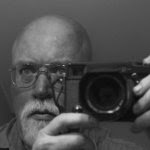This has been, for me, my most highly anticipated lens. This is due in no small part to the fact that I ordered it knowing virtually nothing about it. From an earlier post, one can see that I'm very big on the Voigtländer 50/3.5 Heliar lens. The only two downsides to that lens were (1) that f/3.5 is very slow, and (2) that, in the collapsible LTM design, it felt far less substantial in build quality than collapsible Leica lenses. These concerns were tempered by the resulting lightness of the lens (due to the small lens elements and light build quality).
After a long wait, my 50/2 Heliar arrived today, attached to a Bessa-R3M 250 Jahre body. To digress a moment, the packaging of the kit was very nice, with the camera and the bayonet mount lens hood in a presentation-style box complete with crimson satin. This package would make a very nice gift for a fledgling street photographer. And with bayonet-mount hoods costing ludicrous amounts these days, it was nice to have this included as part of the kit.
Photographs of the 50/2 Heliar and Bessa-R3M can be seen on Stephen Gandy's Cameraquest Web site (Stephen Gandy is one of the few distributors for Voigtländer cameras and lenses in the United States). What the photos cannot tell you is the build quality of the lens. Voigtländer lenses have steadily improved in build quality over the past 5 years. The build quality of this lens is on a par with the recent Zeiss lenses. My immediate impression of the lens was that the diameter and general appearance are similar to a 50/2 collapsible Summicron. The diameter seems larger than the current 50/2.8 collapsible Elmar lens, but it is actually a few mm smaller (at the base). The end of the Elmar is narrower in diameter. The collapsible tube of the 50/2 Heliar, while not quite the precision periscope-like feel of the Elmar, is more stable than the earlier 50/3.5 collapsible Heliar. While the length of the lens full extended (with lens hood in place) is 56mm, the collapsed length is 46.5, a difference of only about 1 cm. Removing the lens hood gives you a more compact 30mm length. The focusing ring at the base of the lens rotates smoothly throughout its range. The aperture ring is knurled from 10:30 to 1:30, but is smooth where the apertures are printed. Unlike the earlier 50/3.5 Heliar, the lens hood does not rotate with the aperture ring. F-stops are at 1/2 stop clicks for all but the f/11-f/16 stop.
While Frances Schultz has complained about the design of lens caps on recent Voigtländer lenses, I like them. The cap fits on the end of the lens without projecting outside of the filter ring. This allows one to cap the lens and then attach the lens hood. Removing the cap with the lens hood in place requires only one finger and a little manual dexterity. Getting the cap back on the lens with the hood in place is more challenging, but I prefer going out with the cap and hood in place. Once shooting commences, the cap goes in my pocket until the end of the day.
No test pictures yet. It is starting to rain as it always does around noon in the New Orleans summer months. I hope to shoot a roll of FP4+ some time tomorrow.


<< Home